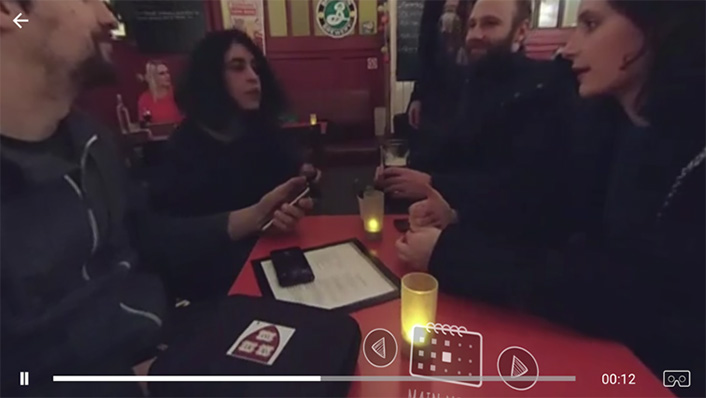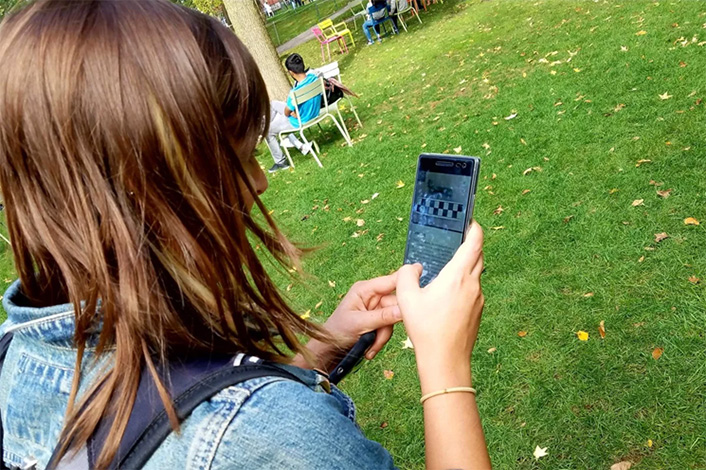Three projects at Harvard University illustrate how AR and VR technologies are transforming the work of faculty and students.

As virtual reality (VR) and augmented reality (AR) technologies make their way into the mainstream, they are enabling new approaches to teaching, learning, and research. Three projects at Harvard University illustrate how these technologies are transforming the work of faculty and students.
Virtual Immersion: French Culture and Language through 3D Video
In Nicole Mills's French language and culture classes, students meet native speakers at parties in their homes and eavesdrop on conversations in Parisian cafés, all without leaving Cambridge. Cultural immersion is a tried-and-true element of language instruction, and this project brings students into the 11th arrondissement of Paris through VR film narratives. Grant funding from the Harvard Initiative for Learning and Teaching (HILT) helped hire diverse Parisians who live in and around the Place de la République to capture their daily lives with VR cameras, giving students a rich, immersive, and multimodal experience of Paris in unexpected and unexplored ways (see figures 1–3). Students said that VR experience allows you to "truly feel like you are living and breathing with the other people in the scene" and that they were "finally able to see firsthand how Parisians truly interact."



What Did the Egyptian Pyramids Really Look Like?
From 1904 to 1947, Harvard and Boston's Museum of Fine Arts (MFA) conducted archaeological excavations on the famous Giza Plateau. Since 2000 at the MFA and 2011 at Harvard, the Giza Project has been digitizing the extensive documentation brought back by the excavators (photos, maps, plans, diaries, object information, etc.) In recent years, the project has been building a 3D virtual reconstruction of the Giza Plateau as it may have looked when first built, around 2500 BCE, providing new pathways for teaching and research about the pyramids and their surrounding cemeteries (see figure 4). To date, the project has recreated all the major pyramids and temples, as well as approximately 20 tombs and other monuments in detail, with many more still to go. The 3D models appear in several courses, including a free online course, Pyramids of Giza: Ancient Egyptian Art and Archaeology, offered through HarvardX, using both an immersive 3D stereo display lab and, increasingly, 3D headsets.

In a related project at the Harvard Semitic Museum, visitors use an AR app to interact with a vivid replica of the Dream Stele, including translations of the hieroglyphs on the stele (a stone or wooden slab used in monuments), and 3D views of the stele in its actual location at the foot of the Great Sphinx of Giza (see figure 5).

Bringing the Historical Campus to Life: Harvard Yard Archeology Project
As part of the commemoration of the 350th anniversary of the 1655 Harvard Indian College, the Peabody Museum of Archaeology and Ethnology, the Harvard University Native American Program, and the Department of Anthropology began an ongoing collaboration to study 17th-century Harvard and its overlooked histories.
In fall 2016, students continued campus excavations, focusing on the location of Harvard's 17th century campus, which included the Old College—the oldest university building in the country—as well as the Harvard Indian College, other structures, and land. Archaeological and historical records of early Harvard bring to life the experiences of this institutional community, teaching us not only that there is an untold story to be unearthed but also that we may have some things in common with our antecessors. As such, archaeological data recovered from Harvard Yard provide a rich and nuanced view of the 17th-century through 19th-century lives of students and faculty who lived and worked there.
You can view the 2016 excavations conducted at the location of the Old College building and explore student research regarding artifacts that were recovered via an AR application and the accompanying Omeka site. In fall 2018, excavations will resume just west of the 2016 location, and students will be able to add their own findings to the collection in the app (see figure 6).

Looking Ahead: Possibilities for Immersive Learning Experiences
What new stories will we tell? What more can we say about the first campus buildings and the institution's earliest students? Most importantly, how do we preserve that history and heritage and continue to make it both accessible to and engaging for the public? In these projects, virtual and augmented reality are enabling Harvard faculty to bring their research and teaching to life in new ways, while students are actively exploring the university's fascinating past.
Annie Rota is Director of Academic Technology for the Faculty of Arts and Sciences at Harvard University.
© 2018 Annie Rota.
